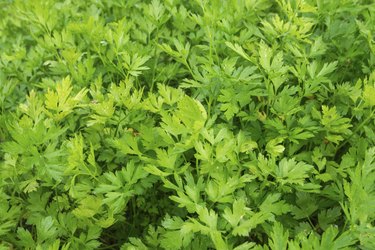
Celery and parsley come from the same botanical family as carrots, parsnips, dill, fennel and hundreds of other well-known plants. Although the crisp, fibrous stalks that make up a typical head of celery don't bear much resemblance to the abundant, aromatic green leaves of fresh parsley, the two foods are closely related.
Celery
Video of the Day
Americans are most familiar with pascal celery, a highly cultivated variety that's considerably less stringy than wild celery. Although the plant's leafy green top is commonly discarded, celery leaves are edible and -- like parsley -- quite flavorful. Celery is a low-calorie source of vitamin C, potassium and dietary fiber. You can eat it raw or incorporate it into cooked dishes.
Video of the Day
Parsley
Fresh parsley is considered an herb, meaning it's generally used to complement or flavor other foods. While its long, thin stalks are edible, the plant is valued for its bright green leaves, which are low in calories and rich in vitamins A, C, K and folate, as well as iron, potassium and dietary fiber. You can eat parsley either raw or add it to cooked dishes just before serving.
Considerations
With its ultra-thin stalks overflowing with bright green leaves, you could easily mistake leaf celery -- also known as herb celery -- for flat-leaf, or Italian, parsley. Leaf celery is just as flavorful as parsley -- and you can eat it raw or very lightly cooked. Chinese celery, which is often available in Asian markets, looks like a cross between traditional celery and flat-leaf parsley.